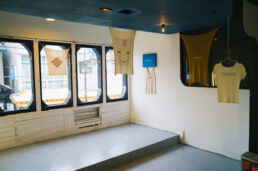What Vacant Houses Tell Us About the History of the City
FUJI TEXTILE WEEK 2022 utilizes various “vacant houses” in the city as venues for the event.
The general information center was formerly a tobacco shop. Its second floor used to be a coffee shop named “Nicole” and is now the venue for Patrick Carroll, an artist living in the U.S. The now rare paper wallpaper (most wallpaper these days is vinyl cloth) and retro rounded corner windows work in harmony with the nostalgic artwork, creating a warm and welcoming space.

A little further north on the shopping street, in an area known as “Higashiura,” the venue where Goro Murayama’s works were exhibited was the “old yarn shop. This area used to be one of the leading textile production centers in Japan, and naturally there were many stores dealing in yarn, dyeing, and other materials, and this was once a woolen yarn merchant as well. At the entrance, there is an explanation that the former owner of the store was also a person who laid the foundation of the culture of Fujiyoshida. The old earthen floor and tatami room style, with well-maintained glass doors, allow us to imagine the careful lifestyle of those days. It is a difficult work to understand that the artist’s drawings are expressed in Jacquard weave through a mathematical model, but the fabric is so tightly woven that it does not look like weaving at first glance, and the patterned paper (cardboard with data of the design used for Jacquard weaving) stretched around the perimeter of the work, when one learns its origin, one feels that this is the right place for it, I feel that this is the right place for it.

The “Old Bunka Fashion College,” where works by Hélène Lauth, Goro Murayama, and Katsura Takasuga were exhibited, was the largest building of all the venues. The works of Katsuyoshi Takasuga and Katsuyoshi Takasuga, which depict textiles returning to the earth, were synchronized, and I even felt a kind of exhilaration. Just as there are a certain number of “ruins maniacs” in the world, the comfort of seeing things decay and disappear is something that we strongly seek as an antithesis in this age of overabundance of things and the constant pursuit of new creations.

In a sense, an “empty house” in a town is like a time capsule that holds the memories of that town, allowing us to recall what the town used to be like through its empty houses. For example, in the case of Fuji-Yoshida, visitors can learn how people lived during the period of its prosperity as a textile production center, and can also catch a glimpse of its connection to the culture and water of Mt Fuji. The local volunteers who served as guides at each site told us stories of their high school days when they used to go to the old “Nicole’s” coffee shop and when they studied Western clothing at Bunka Fashion College.
Vacant houses, if left unattended, can darken the city and make it unsafe. However, it is not easy for owners to clean up vacant houses or take the risk of renting them out in the midst of their busy daily lives. In such a situation, by using the event as an opportunity to open and clean the shutters for the first time in years, users may emerge who properly understand the quality of the building and its relationship with the town. As a result, several of the buildings that served as exhibition venues during the previous year’s event were now renovated and used as cafes and offices. I realized that the significance of holding an art event in a local town, as opposed to an art museum, lies in this as well.
Art expands industry. Industry colors the city.
Other interesting artworks and the “WARP & WEFT” exhibition of production areas were also worth seeing. By focusing on textiles as the theme, I feel that the structure of “art extending industry and enjoying the city through industry” became clear.
Before Corona, Fujiyoshida was an area that attracted approximately 5 million tourists a year. The view of Mt. Fuji became a hot topic on SNS, and some people even said that it was dangerous because people were flooding the roads from the intersections to try and capture the image. The Corona Disaster has changed styles of tourism, and people are now advocating micro-tourism and industrial tourism, in which visitors delve deeply into the history and industry of the city in a narrow and maniacal way. TEXTILE WEEK 2022 will be held in the city of Fujiyoshida, and will be a great opportunity to showcase the charm of the city through the horizontal axis of art (in the case of this city, perhaps weft would be more appropriate) the charm of the city came to the surface. As the city recovers from Corona, the tourists flooding the streets are returning, and this is becoming a symbolic view of the city, but I am not the only one who wishes to see a little bit of the context intertwined with the land, if possible.

Written by:
Yumi Igarashi
I live in Yamanashi Prefecture. I worked for a resort hotel management company for 10 years, and after visiting Karuizawa, Ishigakijima, and Fukushima, I've been working as a freelance hotel management advisor and writer for several years. I don't remember how I got involved with Saruya, but I've been coming and going, helping out with work or just visiting.






